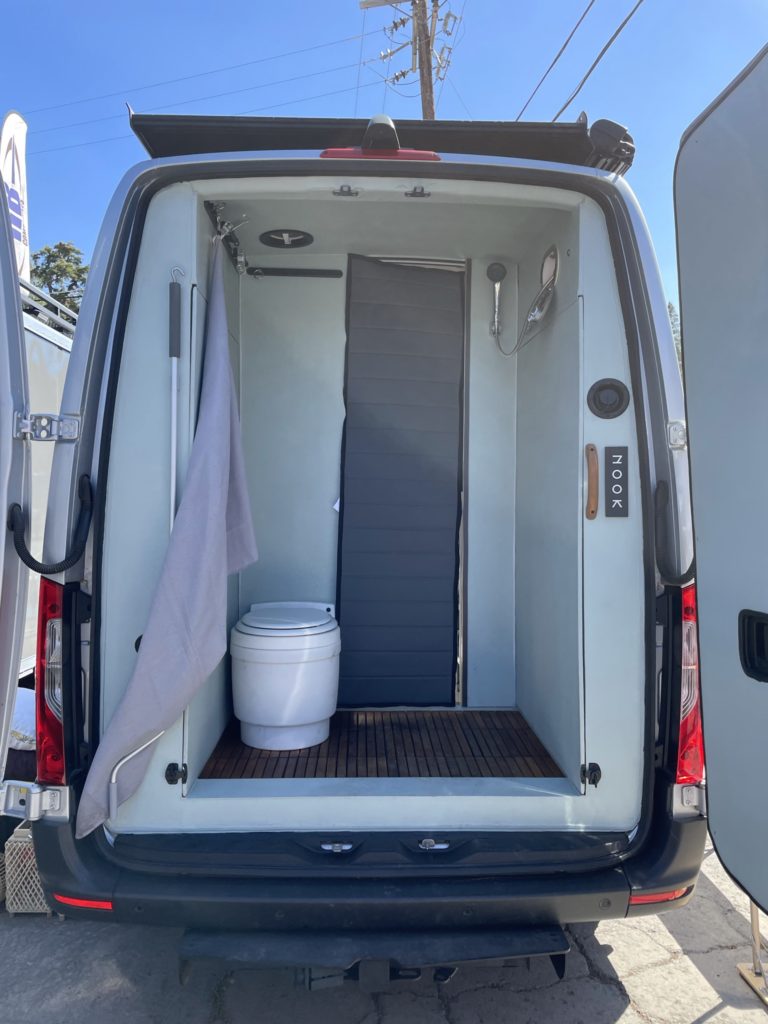
It used to be that living in a van down by the river was a bad thing. Now, everyone wants to live in a van down by the river. If you want to live the van life, but can’t live without a toilet, you have some options. But you might be wondering, “Which is the Best Toilet for a Camper Van?”
The best toilet for a camper van is a dry flush toilet. A dry flush toilet is like a diaper genie. After you do your business, you simply push a button and the dry flush toilet wraps the waste into a bag that you can dispose into the trash. There is no odor and no clean-up. There are two brands of dry flush toilets, the Wrappon Green and the Laveo toilet.
Read on to find out more about dry flush and other camper van toilets.
Dry Flush Toilets
The two models of the dry flush toilet are the Wrappon Green and the Laveo. We’ll discuss each one.
Wrappon Green
As I mentioned, the dry flush toilet is similar to the diaper genie. It utilizes a cartridge-based system that is a smell-proof and leak-proof system. Dry flush toilets are fully self-contained so they are a great toilet for travel trailers, camper vans, and winter fish huts. If you don’t want to be in contact with your waste at all, a dry flush toilet is your best option.
With the Wrappon Green, you’ll get about 50 “flushes.” It comes with a remote control that tells you how many flushes you have used. In addition, the bag system has a red stop line that shows you when you are almost out of bags. The system operates on either AC or DC power. Wrappon Green also has it’s own stand-alone battery.
The five-layer film is what keeps the odors from escaping. The cost for the 5-layer film with 50 flushes is just under $60.00, while a container of the coagulant is about $30.00 for a pack of 50. With the Wrappon Green, each “flush” discharges a bag of waste.
Laveo
Downside of Dry Flush Toilets
While the dry flush toilets are the best option for campervans, they are also the most expensive option. Both the Wrappon Green and the Laveo start at around $1000.
Plus, you have to purchase the refill cartridges and the coagulant at an additional cost. And, you’ll need to have power to “flush” these toilets. Both toilets come with a battery, but you’ll need a way to power that battery.
| Costs | Best Toilet Type |
| Expensive | Dry Flush |
| Mid-Range | Portable |
| Low Cost | Bucket |
Composting Toilets
Composting toilets are also expensive and require more contact with your waste. The advantage of the composting toilet is that, like the dry flush toilet, no water is needed.
This means you don’t have the inconvenience and weight of hauling around the extra water for a toilet and you won’t need a waste tank. Plus, you can stay off-grid in your van longer when you don’t have to carry as much water. And, the water you do carry can be used for things like dishes and showers.
A composting toilet has two compartments. One compartment is for urine and the other is for, well, the other stuff. So men, yes you have to sit down while you pee unless you are very, very on target.
Unlike the dry flush toilet, the composting toilet requires a vent. The fact that you aren’t mixing the dry and the wet waste helps keep odors down, but not completely. That’s where the vent fan comes in. You’ll also need to get electricity to the vent fan, which relies on 12 volt power.
The urine compartment can be dumped into a toilet, a dump station, or in the wilderness. Most people urinate into holes that lead to the urine receptacle. After that, they use a spray bottle filled with vinegar to spray the toilet in order to reduce the urine smell.
The urine tank will need to be emptied every 2-3 days for one person and every 1-2 days for two people.
The dry waste container can be filled with damp coconut fiber or peat moss. However, coconut fiber is a more sustainable product than peat moss since it is a waste product of the coconut industry. After you do your business, turn the hand crank on the toilet to mix the poo with the coconut fiber.
In reality, composting takes a lot longer than the amount of time that the waste will sit in the tank before disposal. You will have to empty this compartment about every 1-2 months. When you do, you can place the waste in a trash bag and throw it in the trash.
Adding toilet paper to the dry waste portion of the toilet increases the frequency that you’ll need to empty the dry waste container. But if you throw the toilet paper in the trash, then you have smelly toilet paper sitting around.
They are not my favorite for two reasons. First, you have to manage the waste. Then you have to modify your van to accommodate a composting toilet.
Even though the supplies for a composting toilet are inexpensive, the composting toilet itself is comparable in price to a dry flush toilet. Plus, they take up more room than a dry flush toilet.
There are many brands of composting toilets, but Natures Head and Air Head are two of the most popular ones.
Natures Head
Installation of the Natures Head toilet is very simple. You just install two brackets to the floor and attach the toilet to the brackets. The Natures Head has a large molded one-piece plastic seat that is different than the seat in your household toilet.
The vent fan on the Natures Head is inside the unit whereas the Air Head vent is on the end of the hose that vents to the outside of the van. The liquid waste bottle on the Natures Head toilet is slightly larger, at 2.2 gallons than the waste bottle on the Air Head, which is 2 gallons.
Of the two toilets, the Natures head is slightly larger than the Air Head, so it takes up more room. You have to lift the top compartment to get the urine container out. Every time you do this, you are exposed to the solid waste in the bottom of the toilet.
To remove the dry waste compartment, you have to slide it off the top of the toilet base. In a small space, like a van, you may not have the room for this maneuver. Plus, there is a pin that you have to line up to get the compartment back on, so it’s a little complicated to get the dry waste compartment back on the base.
Air Head
There are a few things that these toilet owners like over the Natures Head. One is that there is a vent screen. A common problem in composting toilets is that bugs like to fly down the vent and join the party. This is not a fun experience while you are doing your business. The vent screen on the Air Head toilet prevents bugs from entering.
Another advantage of the Air Head toilet over the Natures Head Toilet is the fact that the Air Head has an opaque urine receptacle. The last thing you want to do when you are dumping the urine container is to call attention to yourself as you carry a large clear container of yellow urine. Although the Air Head urine tank is opaque, it still has an indicator on the receptacle so you can see when it’s full.
The toilet seat on the Air Head, while smaller, is similar to the seat that you have in your home toilet. On the marine version of the toilet, the lid has a seal and the seat is smaller than the lid on the household version of the toilet.
The dry waste container on this toilet has handles, so it’s easier to carry and dump. Plus, it comes with a cover that you can place on top of the dry waste compartment, which seals the compartment for transport.
The handle on the urine container of the Air Head is metal, while the handle on the Natures Head is a rope-like fabric. I have a couple of problems with the fabric handle. For one, the handle can get urine on it. Plus, the Natures Head handle doesn’t seem as sturdy as the metal handle on the Air Head.
While you have to be very accurate peeing in the Nature’s Head toilet, in the Air Head toilet you don’t have to be that accurate. Air Head claims that men can pee standing up in their toilets.
While I wouldn’t prefer a composting toilet, if I had to choose, I would go with the Air Head toilet.
Urine Diverting Toilets
A urine-diverting toilet is another option for your van. The toilet collects the urine in one tank and the poop in a different container.
Separett
Separett is one brand of urine-diverting toilets. With this system, a ventilation system must be installed. Plus, you’ll need to get power to the ventilation system.
To dump it, open the compartment and remove the urine recepticle. Dump the urine into an appropriate location. The poop compartment is lined with a bag. You can buy bags from Separett or use a regular trash bag.
These toilets are fairly expensive at around $600.00. And, you’ll have to dump your poop. I don’t know about you, but I don’t want to be that close to my poop.
Cassette Toilets
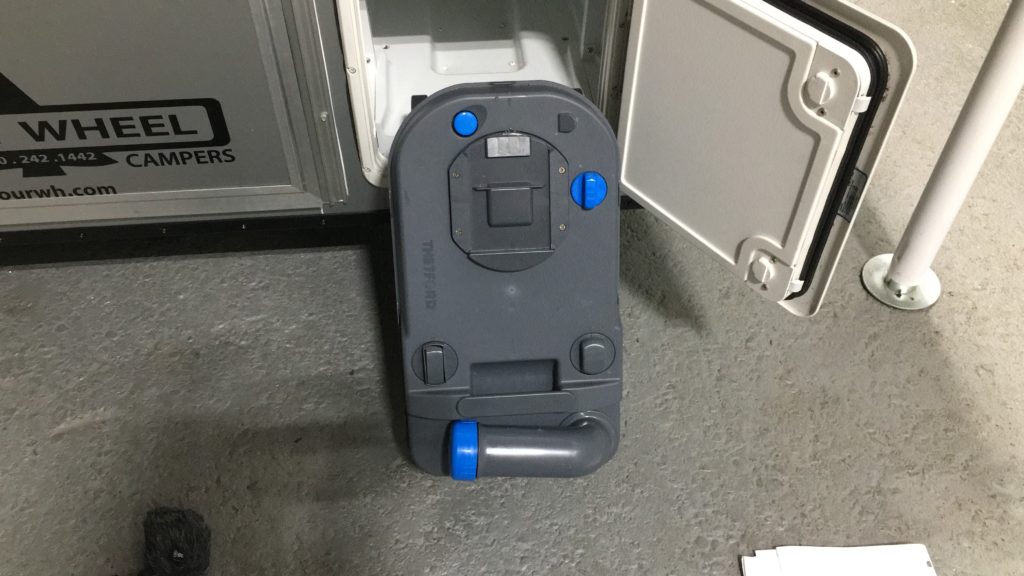
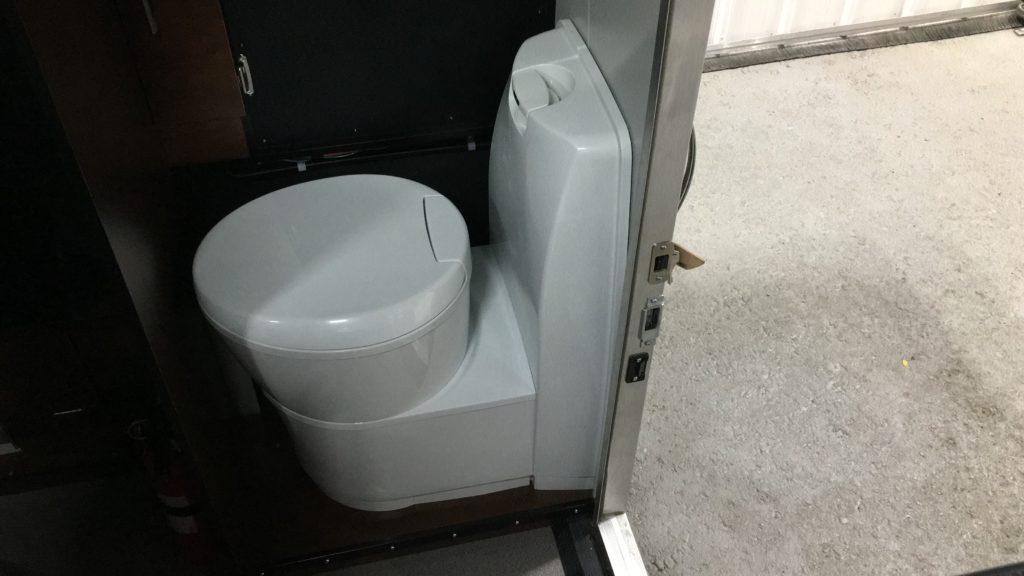
Cassette toilets are common in smaller campers, including camper vans. The camper van that we rented in New Zealand had a cassette toilet. The toilet is very straightforward.
After you add deodorizer to the tank, you push a button to add water to the toilet bowl, do your business and flush the toilet. The waste goes into the holding tank. When you are ready to dump the tank, go outside your van and pull the tank out. It can be dumped in a dump station or toilet.
One of the downsides to a cassette toilet is that you have to drill holes into your van to make a compartment for the holding tank on the outside of the van. This is a tricky and complicated installation.
Also, most cassette toilets have a very small holding tank, around five gallons. With a holding tank this small, you’ll have to dump frequently. With the two of us in New Zealand, we had to dump about every 2-3 days.
Portable Toilets
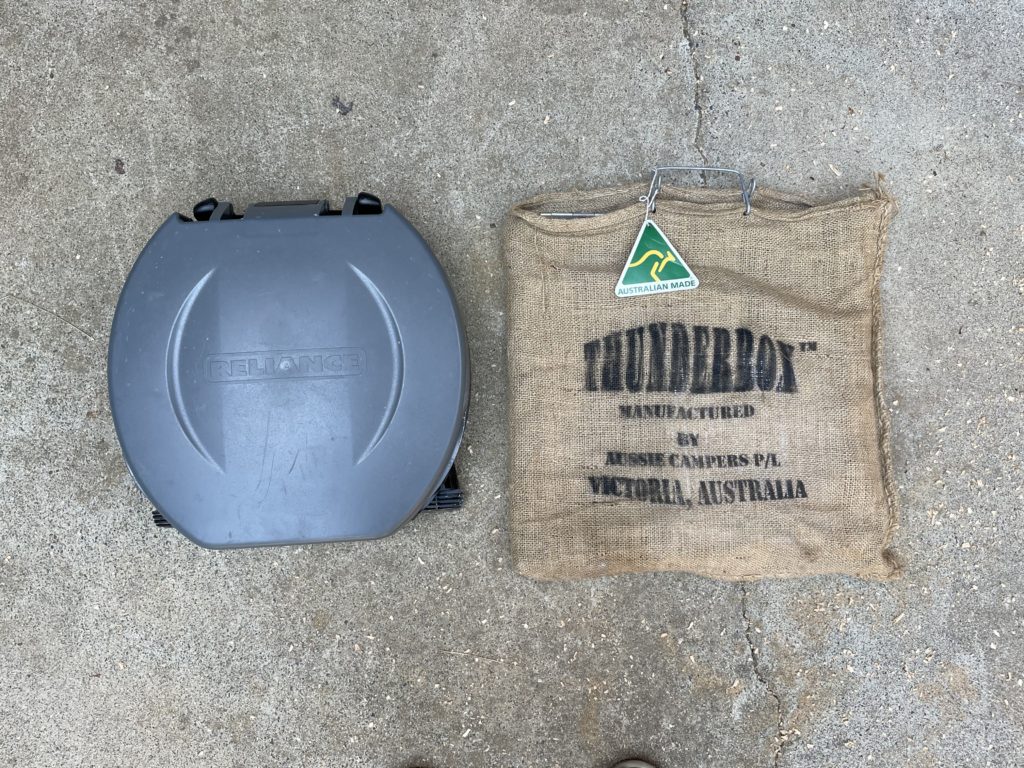
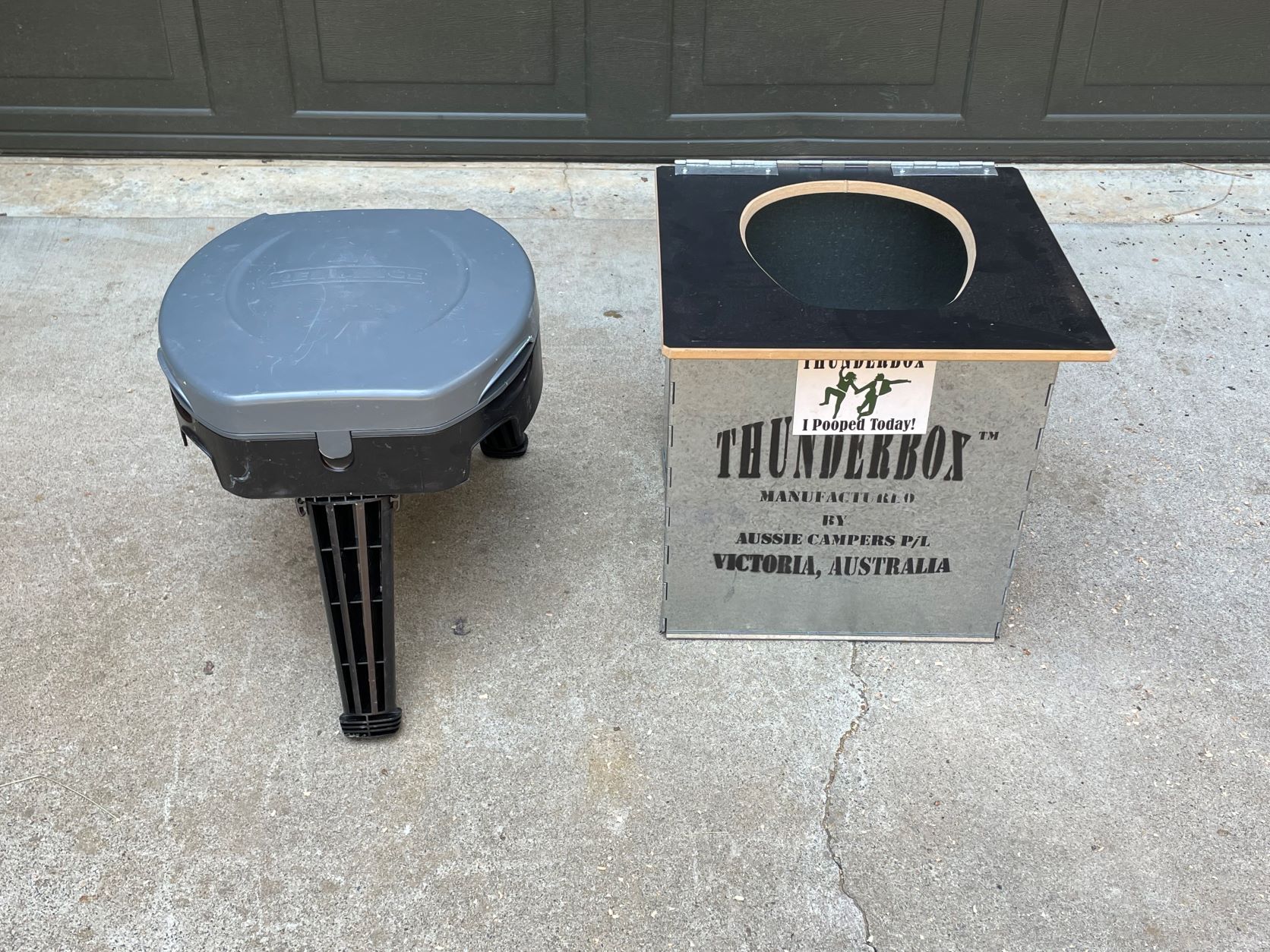
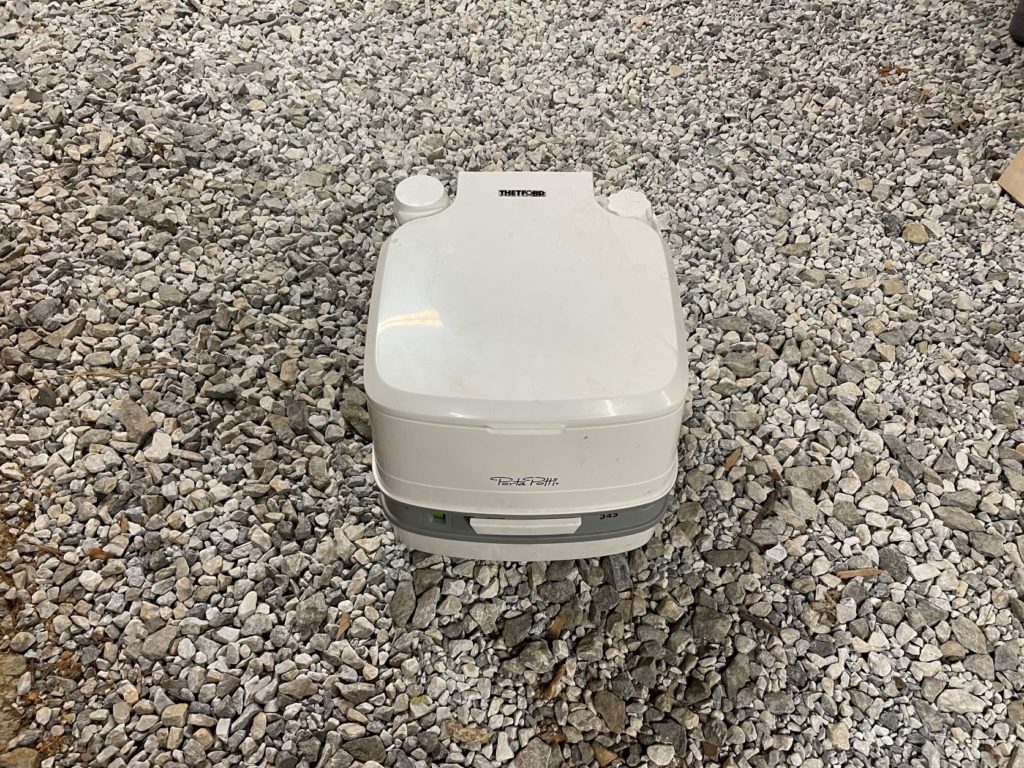
A portable toilet is one of the least inexpensive and easy-to-use toilets. It doesn’t require any installation and you can use it anywhere. Many portable toilets are small and easy to store, that’s why they are so common. You can store them in a closet or under the bed.
If you’re out in nature, you can put them inside a shower enclosure tent outside of your van and use them there. Many portable toilets come with a container that holds the waste. When full, you simply empty the waste into a toilet or dump station. The holding tanks on these toilets are fairly small, so you’ll have to empty them every two to three days.
There are some portable toilets that are basically just a seat. You add a bag to the seat and go in the bag. Adding coagulant is definitely recommended to avoid leaks. When you are done with that, seal up the bag and throw it into the trash. Some of these portable systems, like the Thunder Box, come with their own bags that fit the specific toilet.
Bucket Toilets
Can you really poop in a bucket? Why yes, you can. This is by far the least expensive toilet to purchase. You can either buy a bucket and purchase the seat separately, or buy a bucket toilet. It’s easier to clean and dispose of if you line it with a trash bag. I’d get a heavy-walled trash bag because you don’t want it to break when you are throwing the bag in the trash.
Before use, place a small amount of absorptive material like sawdust or dampened coconut fiber in the bag-lined bucket. After each use, place a small amount of the absorptive material on top. This will help to reduce the odor and keep the contents from sloshing around.
While they are cost-effective, I find the bucket toilet to be uncomfortable. To me, the bucket does not seem very stable.
Flushing Toilets
A flushing toilet is probably one of the least common types of toilets for small camper vans. Most small vans don’t have the room to accommodate a fresh water tank and a waste holding tank. Plus, flushing toilets require more work in the installation.
You can certainly install one or have one installed. And you can also purchase camper vans that already have flushing toilets.
Most of these camper vans will be on the larger side for the reasons that I mentioned. A flushing tank works the same as an RV toilet. You add chemical to the waste water tank and water to the fresh water holding tank.
When you use it, fill the bowl with water, do your business, and then flush. You can empty the holding tank at an RV dump station.
Conclusion
No matter which one you choose, a toilet will definitely make your journey more enjoyable.
